A small amount of light scurf that appears daily in the tongue due to the activity of bacteria and disappears after cleaning is a normal phenomenon. An alarming signal may give a suddenly changed color, for example, a person’s blue tongue, the reasons for which indicate possible malfunctions in the functioning of certain vital organs.
In order to competently organize self-monitoring of the state of the language in order to identify signs of incipient diseases on its surface, it is necessary to know which factors and indicators need to be guided.
Blue Tongue Tongue - Causes
- The color has a fairly wide range of variations: transparent, white, yellowish, brown, gray. A red, green, crimson, and black tint may also appear. In children, it often turns out that the bright color was caused by a felt-tip pen, which has been in the mouth. This may be a caramel cock, drink, chewing gum. Therefore, before panicking, trying to understand why a child has a blue language, it is necessary to analyze the ration preceding this event. Adults observe color changes after drinking coffee, and smoking contributes to this.
- The invoice differs in several options for flying:
- dry;
- homogeneous;
- wet;
- oily;
- dense;
- loose.
- Sediment thickness is one of the key parameters. If during a visual inspection it turns out that the raid increased the degree of intensity and there is practically no pinkish lingual surface through it, control over the state of the body should be strengthened. When you save the picture during the day, it is advisable to apply for appointments for examination.
- The localization of the spot of clearly defined deposits in a specific area of the tongue makes it possible to determine the location of the pathological focus in the body.
- The ease of removing plaque shows the degree of pain. The normal translucent layer is scrubbed during the morning hygiene events and does not appear all day. The deposits that appeared due to failures in the functioning of specific systems are not completely removed, but after a while they become even thicker and acquire the color tone characteristic of the underlying disease.
A touch of a healthy person is transparent, whitish. It does not cover the view of the tissue of the tongue, it is easily removed, it does not smell. In winter, it may be slightly yellowish.
Causes of blue bloom
It is advisable to collect and analyze all cause-and-effect manifestations, which make it possible to uncover the problem, why the language is blue in humans, in order to notice important signals in time. This shade can appear when trouble in the heart. The localization of this color on the lower surface indicates circulatory disorders, burdened by cardiopulmonary insufficiency.
![]()
What to do if there is a blue patina on the tongue
A bluish tinge on the tongue appears with scurvy. It may also reflect insufficient blood circulation. For a specialist can serve as evidence of poisoning with mercury or other heavy metals. If at the edges of the tongue section, located in front of the pharynx, a blue raid suddenly appeared on the tongue, the reasons lie in the kidney area. This kind of indicator can warn of a serious illness. Blue-black spots disappear only after normalization of the functioning of the adrenal glands in the production of hormones.
The cyanotic upper plane becomes an accurate sign of the onset of development of cardiovascular insufficiency without the presence of other symptoms in the form of pain, a feeling of pressing heaviness, weakness. This will allow for a set of preventive measures to prevent a heart attack.
Types of raids appearing in the language
The variety of raids arising on the language surface has its explanation, based on their characteristic outlines, color shades, localization.
- The entire tongue was covered with a dense whitish bloom with a simultaneous increase in temperature - an infectious disease.
- White deposits appeared in the middle of the tongue with simultaneous appearance of cracks on the sides - pathological changes in the intestine or stomach. At the first manifestations, it is advisable to follow a dietary digestible diet without fatty and salty foods. If you feel pain, you should immediately be examined and get medical advice.
- Deposits with a white tint in the front area are pathological manifestations in the respiratory system, one of the reasons for which may be smoking.
- Whitish patches of deposits throughout the tongue are a fungal infection resulting from the development of dysbacteriosis. It is often a consequence of the uncontrolled intake of antibiotics.
- The presence of spotted patches of red and white is an alarming signal, since so often symptoms of scarlet fever appear. Modern medicine has effective methods of curing this insidious disease, the main thing is to ask for help in time.
- The yellowish shade of sediment in small quantities should not cause concern. But with their considerable thickness and intensity, it is possible to make a conclusion about possible inflammatory foci of the gallbladder. If at the same time pains began to disturb the right under the ribs - it is worth being examined for the diagnosis of cholecystitis.
- The gray tint of the plaque indicates malfunctions in the gastrointestinal area, including increased acidity due to malfunctions that caused dehydration and impaired microflora.
- The transformation of the plaque into a brown crust can warn of food poisoning. If there is little sediment, it is worth analyzing the ration for identifying products that could dye them in brownish color scheme (chocolate, coffee, cocoa, strong tea). Non-disappearing plaque may indicate dysbacteriosis.
The black color of the deposits should be alerted, as this may be a sign of the transition of the disease to a critical phase.
The causes of the appearance of plaque in the child
Daily inspection of the internal integument of the oral cavity should be a mandatory procedure. A light thin whitish layer on the tongue, disappearing after hygiene or eating is normal. If during the day the whiteness does not disappear, and the layer of plaque thickens, it can be assumed that the baby has a common fungal infection, usually called thrush.
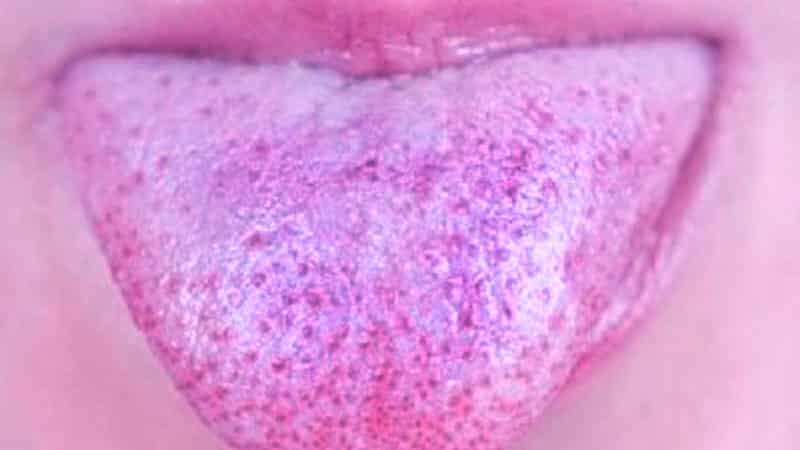
Why raid blue on tongue
If this disease is not treated, painful ulcers will develop in a timely manner, which will cause the child to worry and cry. Whitish rashes also manifest themselves during colds, disappearing after recovery. Parallel to the whitish blot of stomach upset, vomiting should alert the parents and facilitate the immediate receipt of a qualified medical opinion, as this may be gastritis.
Blue language in a child requires special attention, one of the key indicators capable of reflecting a whole range of pathological problems in various important sectors of the body:
- respiratory system;
- heart (angina, arrhythmia);
- circulatory system;
- the kidneys.
Kids who are not yet able to speak cannot express the discomfort that has arisen from incipient diseases, and parents do not always know how to correctly identify a child’s crying as a result of the pain experienced. Therefore, any signal should serve as the beginning of close observation and in the detection of abnormalities of immediate treatment to doctors. Often blue tongue in infants is associated with disorders of the nervous system, accompanied by convulsions, malfunctions in the functioning of the cerebral circulation.
Ways to purify the tongue
To clean the tongue surface of the resulting plaque does not require the use of complex techniques. The usual available fixtures will do.
- A toothbrush may not have a special rough lining on the inside, oriented to directly carry out thorough cleansing of thin ordinary deposits with simultaneous massage of the tongue. It is enough to go with medium soft bristles with or without antibacterial paste from the root to the lips, as well as across the tongue to capture the side surfaces.
- You can purchase a special scraper. Usually it is made of plastic, although there are metal or wooden products. Some scrapers are supplemented with special brushes.
If necessary, use appropriate devices, for example, a teaspoon. You can take a bandage, winding it over your finger, or use a clean towel, a textile napkin.
One of the methods of alternative directions in modern medicine is the diagnosis of possible diseases in the human body according to its language.
According to the followers of ancient oriental medicine, the language of a person reflects the state of his health in general, as well as the state of specifically, taken separately, internal organs and entire systems.
Many well-known Russian doctors adhere to the same opinion, in particular, the Russian doctor M.Nechaev.
When a person is sick, it’s pretty easy to determine where the problem is by the state of his tongue. For trained professionals, this is a matter of a few minutes.
But you can even make such a diagnosis yourself, it is enough to know at least the main points, which now will be discussed.
A prerequisite for a qualitative diagnosis is its conduct only in the morning, on an empty stomach. The lighting in this case should be quite bright, sufficient for a good inspection.
Features of the language of a healthy person
The appearance of the language of a practically healthy person:
- Uniform pink surface
- The absence of bumps, irregularities of the surface of the tongue
- The presence of plaque, fingerprints is not noted
- No visible spots of different colors and textures.
- Saliva is distributed over the surface fairly evenly, in a thin layer.
- Clearly expressed straight longitudinal fold
- The papillae are clearly visible, which are rather small at the tip of the tongue, in its middle part they are already larger, and at the root they are even larger and there are more of them than in other areas.
For a qualitative diagnosis, every part of the language is important! Investigating its condition, one can define both the problem of an organ taken separately and the state of the organism as a whole.
Separate areas on the lingual surface are responsible for a specific organ.
The main factors in the diagnosis are the color of the tongue surface, plaque (its localization and the nature of deposits), increase, curvature, deformation of various zones, as well as changes in the papillae (their disappearance, increase, etc.).
Consider the main areas of human language:
- Tip
- The middle part, also called the back.
- Root
- Left and right side surface.
Chinese language health diagnostics - Five Elements
The ancient Chinese theory of the five primary elements (Fire, Water, Metal, Earth, Tree) distributes as follows: the tip of the human tongue is the element of Fire, immediately behind this area there is a zone of the Metal element. The back (central part) is the Earth, the sides are the Tree.
And the farthest zone, the root, corresponds to the element Water.
- Fire Zone (tip)
It is responsible for the functioning of the cardiovascular system and the small intestine. Both of these systems are tightly connected, failures in one system cause instant discomfort in the other. So, the feeling is familiar to many when, due to anxiety, a person begins to experience unpleasant sensations in the abdomen.
Chronic overstrain, stress, anxiety and feelings, a large number of experienced offenses are defined as red spots and points on the tip of the tongue. If at least some changes are detected in this area, then it indicates the hard work of the heart, that it is working in an intensive mode, working for wear, experiencing overstrain and stress.
- Metal Zone (an area that starts right behind the tip zone)
This area is defined responsibility for human immunity, for the condition of the respiratory organs, as well as for the work of the large intestine.
If the color of this area is significantly pale, then you should pay close attention to the state of immunity.
If there is a brown, dark brown color in these places, it is most likely that the state of the respiratory system is already in a completely deplorable state and there are quite serious problems with the bronchi and lungs.
- Tree Zone (sides of the tongue, left and right)
This zone is responsible for the functioning of the hepatobiliary system. This is our liver, gallbladder, all ducts, their condition.
If you find teeth markings on these areas, this means that there are stagnation in the operation of this system.
If there are bluish, greenish, purple spots, then this is a concrete sure sign of already existing diseases in the liver, gall bladder, and disorders of bile outflow (discenisia).
If you find dark spots, closer to black, then, most likely, we will talk about quite serious problems and the conversation with the doctor will be about hepatitis or cirrhosis of the liver.
- Earth zone (central part)
It shows the work of the stomach, spleen, pancreas.
If its color is clearly red, there is yellow bloom, then this is a very specific sign of increased acidity in the stomach or a sign of bile reflux in the stomach.
- Water Zone (the back of the tongue, its root)
Water’s area of responsibility includes many systems of the human body, but the main one is the genitourinary system, which includes the kidneys, adrenal glands, bladder and all ducts, as well as the genitals.
At the very rear of the root are two rather large tubercles. These are ordinary nipples, and this is not considered a deviation from the norm.
Diagnosis of health by language - the main signs of disease
- Raid on the tongue
Pay close attention to the presence of plaque in this part, and also examine the color of the root of the tongue.
If the plaque is thick, if it is yellowish, or the color of the tongue surface is not pink, then most likely there are problems with the urogenital system, infections of the organs that form it are not excluded.
If the plaque on the tongue is thin, then the disease is just beginning; if it is thick, then, most likely, it has already passed into the chronic stage.
Yellowish plaque indicates violations in the liver, gallbladder.
- Longitudinal fold
Pay attention to the longitudinal crease in the tongue. If it is not clearly expressed, if it is not clearly direct, then you have problems with the state of the spinal column.
- Papillary diagnosis
In the language of a healthy person, the number of papillae is approximately ten thousand. What are nipples? These are peculiar analyzers (determinants) of taste, temperature, chemical components of food. Through their nerve endings a connection with the internal organs of the person and their departments - with the intestines, liver, kidneys, spleen, etc. passes.
When diagnosing it is necessary to take into account the time of year. In the summer, the nipples are more red, bright shade than in the cold season, they are larger than in the fall, winter and spring.
In the cold season, they can even be bluish or yellowish. This is acceptable and is considered normal.
Diagnosis of health by language - video
How to care for the tongue?
Research regularly, diagnose your language.
Be sure to purchase a special scraper to clean it of plaque. Do this daily in the morning while you are brushing your teeth. To enhance the healing effect, you can also cleanse the evening before bedtime.
Dentists say that it is 5 times more effective in cleaning the tongue than a toothbrush! (since the toothbrushes are designed to clean only the teeth - also, as a rule, you can feel discomfort or choke when cleaning the tongue with a toothbrush).
![]() Dr. Tung’s, tongue scraper, adjustable, tongue scraper no. 1
Dr. Tung’s, tongue scraper, adjustable, tongue scraper no. 1
- Helps to freshen breath
- Recommended by dentists
- Stainless steel
- Hygienic
- Serves a long time!
- Freshens breath
- Removes bacteria
- Improves taste
- Clears for 10 seconds
- Bestseller!
Designed specifically for cleaning the tongue, this scraper from Dr. Tung is convenient to use, effective and can serve for years.
Cleansing can also be done with a teaspoon, preferably silver, or just a toothbrush.
During the procedure, try to massage the entire lingual surface as much as possible.
This will positively affect the work of your entire body, give you the opportunity to feel better, look more fresh.
Periodically conduct a diagnosis of your health in the language and be healthy !!!
Language is not only a participant in the digestive process, but also acts as an indicator of health. With a number of diseases it becomes visually noticeable that the organ is modified. Improper oral hygiene also leads to the formation of plaque and contributes to the reproduction of pathogenic flora. In the clinic at the reception you can see that the examining doctor asks to show the language. The increased interest of physicians is due to the fact that this body is one of the first to respond to developing pathologies in the body. It is, of course, impossible to determine the disease by language alone, but it is important to take into account its appearance and condition.
The human tongue is presented in the form of muscular tissue, covered with a mucous membrane. The motor activity of the body is provided with striated musculature. In the structure of the language there are four parts: the root, body, bridle and groove.The mucous membrane is covered with cornified epithelium and spliced with connective tissue.
The submucosal layer is absent, so the tongue never folds. The epithelial layer contains taste buds, lymphatic formations and glands.
Considering the role of language in the life of people, probably, the first thing to do is to highlight the opportunity to pronounce articulate phrases. Thanks to this body, a person is able to communicate in society and express thoughts. Without the ability to speak, the lives of people would be incomplete. In the digestive process, the functions of the tongue are numerous: mixing with saliva, providing a swallowing act, promoting food. The body also participates in the process of salivation and chewing.
High tactile sensitivity allows you to feel even minor touches to the surface of the body. Particularly important is the role of language in the process of absorption of breast milk by newborns. High permeability provides the flow of substances into the blood, including from drugs. In medical practice, the diagnosis of diseases by language is important. Changes in the condition or color of an organ are not enough to make an accurate diagnosis, but the symptom is always taken into account.
What the tongue reveals
Often, people who notice that they have formed a raid on the language, just do not pay attention to it. In some cases, this leads to insufficient hygiene of the oral cavity and after cleaning, the state normalizes. If, after performing preventive procedures, the plaque is preserved, then it is necessary to consult a doctor. Normally, the language of a healthy person is pink in color and is covered on top with a thin film that has a white tint. If a plaque was formed, then the natural color and texture of the organ are not visible upon visual inspection.
When diagnosing diseases, it is not possible to rely only on plaque, since not always “coated” language is a determining factor. Some foods and beverages with coloring matter in the composition cause discoloration. Prolonged therapy with drugs, especially antibiotics, also leads to the formation of plaque.
Discoloration of the tongue in diseases
The definition of the disease by language is not only a visual assessment of the resulting plaque, but also take into account the color and texture. A close relationship with the internal organs leads to a change in hue with the progression of pathological disorders. When assessing the color of a language, the following deviations can be identified:
- White color indicates anemia, infectious pathologies, diseases of the gastrointestinal tract or respiratory system.
- Red tongue is marked with strong heat, fever, cardiovascular disorders, pathologies of the stomach and spleen.
- Violet color indicates severe intoxication with alcoholic beverages, impaired blood circulation. If yellow plaque formation is also noted, then this is a sign of a disorder in the spleen or lungs.
- Blue tongue indicates the terminal stages of fever and diseases of the cardiovascular system.
- Black color, affecting the entire surface of the body - an alarming symptom and requires urgent medical attention. The color of the tongue can be a sign of cholera, Crohn's disease, candidiasis in a prolonged form, heavy metal poisoning, infection of the urogenital system and infection with fungi.
- Yellow color indicates liver disease with impaired outflow of bile or pathology of the digestive tract.
- Gray tongue may be a sign of abnormalities in the functioning of the cardiovascular system of the body or the gastrointestinal tract.
- Blue color indicates violations of the heart.
- Brilliant smooth tongue with a pronounced bright red color is noted in patients with malignant tumors of the stomach, with colitis in chronic forms, lack of vitamin B.
- A dark brown color with a thick, coarsened bloom on which cracks are formed indicates pellagra (a deficiency in nicotinic acid and vitamin B). In the later stages there is a red tint.
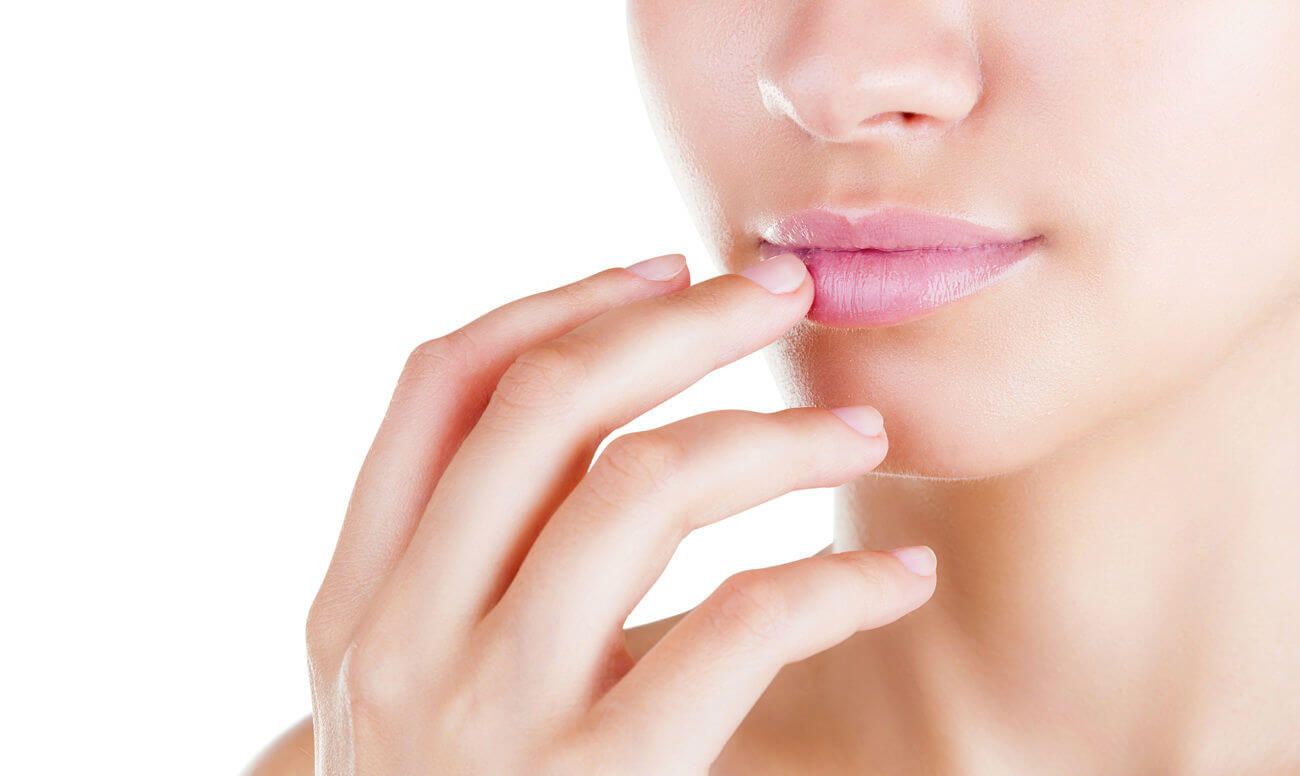
When making a diagnosis, doctors do not rely solely on the color of the language. It is important to take into account the symptoms, the results of studies and the existing pathology of the patient in history. You can assume the disease on the color of the tongue and the resulting bloom, but the doctor will be able to make an accurate diagnosis only after a full examination.
Other changes in the state and structure of the language
On examination of the patient, doctors pay attention to the structure of the tongue. Normally, there are nipples on the surface, which are clearly visible. A fold passes in the middle, dividing the organ into two equal parts. In the summer, the nipples have a reddish tint and slightly enlarged, in the winter yellow color is characteristic. The language is associated with internal organs, and pathological disorders may not affect the entire surface, but affect only a part. So, on the sides of the root (posterior third) there are deviations in the work of the kidneys, and in the center of the pathology of the intestine.
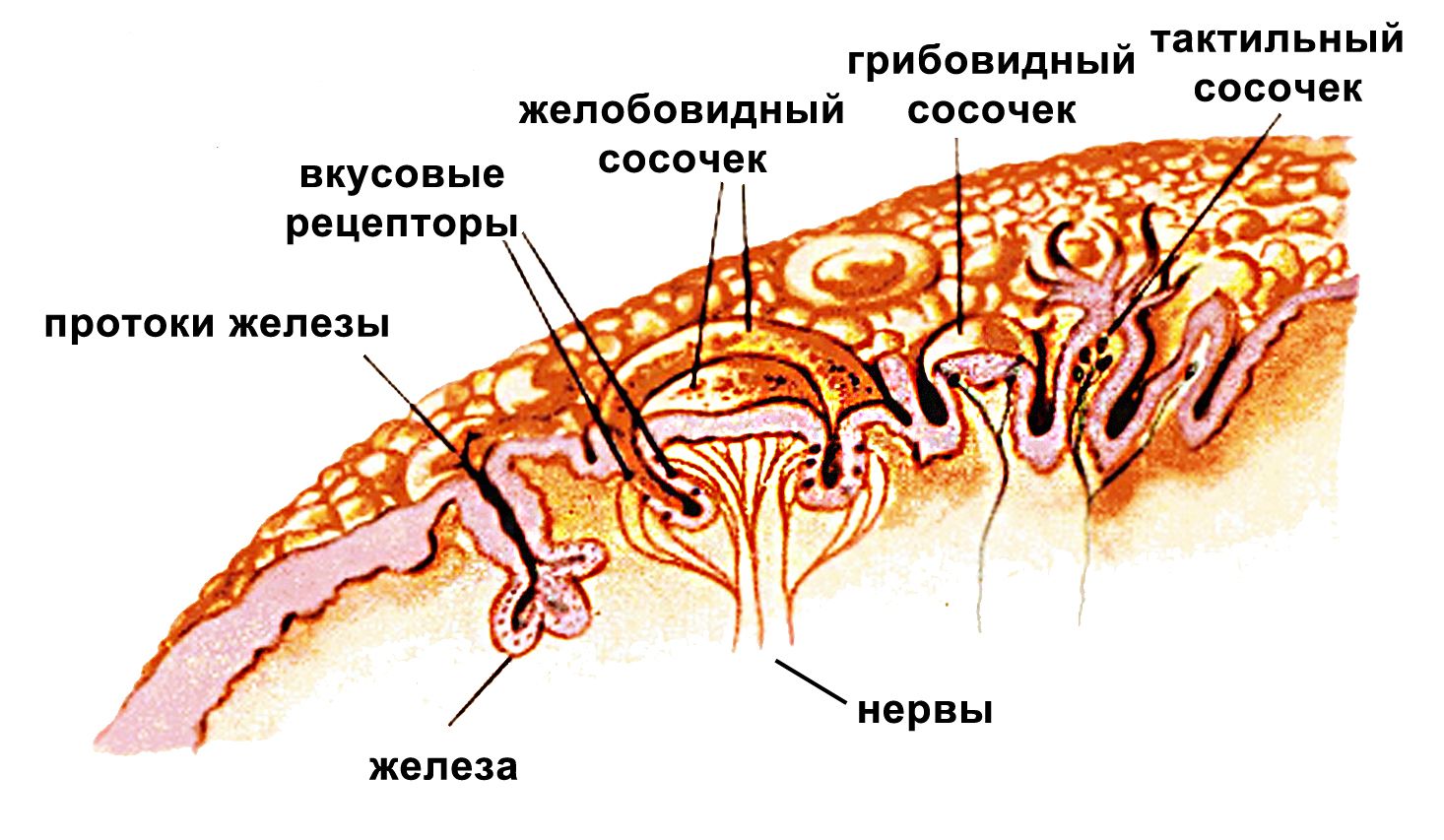
Disturbances in the functioning of the digestive tract, liver and spleen are reflected in the middle part of the organ. Diseases of the cardiovascular system lead to modification of the center of the tip, and along the edges pathologies of the respiratory system appear. Language reacts quickly to the progression of many diseases. Often this symptom helps to reduce the number of examinations required for diagnosis. On examination, the doctor determines the possible cause of the violation, and then confirms the assumption by test results.
For a more accurate definition of the disease by language, attention is also required to pay attention to the form and condition of the organ. Important factors are:
- swelling indicates digestive disturbances;
- thickening occurs when abnormalities in the functioning of the liver and gastrointestinal tract;
- the thin form of the organ indicates blood diseases and metabolic disorders;
- lengthening occurs in pathologies of the heart;
- curvature of the central band is observed in patients with diseases of the spine;
- increased bulge occurs in the pathologies of the lungs;
- a change in the mucous membrane is characteristic of a lack of vitamins in the body;
- a strong tremor of the protruding tongue is noted in the neuroses and pathologies of the endocrine system;
- with rheumatism, two white streaks form on the surface of the organ;
- increased dryness occurs when dehydration, peritonitis, heavy blood loss, diabetes and endocrine system pathologies;
- the formation of white plaques is characteristic of stomatitis, candidiasis and dysbiosis;
- small ulcers of white or yellow color are characteristic of conditions accompanied by increased acidity of the stomach;
- papillae inflammation occurs in pelvic pathologies.
In the diagnosis, the degree of perception of tastes by the patient is taken into account. Mouth odor combined with discoloration is also taken into account.. For example, the sharp smell of acetone indicates diabetes mellitus, ammonia for kidney disease. Putrid odor - a sign of disorders in the digestive tract or diseases of the teeth.
Oral hygiene is recommended daily. During the execution of procedures it is required to pay attention to the state and color of the language. If any changes are found that persist after hygienic procedures, it is necessary to consult a doctor. It is much easier to cure the disease at the initial stages of development than in the prolonged stages. To change the color and shape of the tongue leads to a large number of diseases and only a qualified doctor can determine what exactly caused the violation.
Human language is a kind of indicator of the body. If suddenly any body "fails", then it is sure to notify its owner of this by changing the color.
Every day a small amount of plaque appears in the tongue and this is normal. It is caused by the activity of bacteria and disappears after each cleaning. In case the taste organ changes its color and becomes, for example, blue, the alarm should be sounded. This color can signal possible malfunctions of vital organs. Well, if this is the initial stage of the disease. A timely visit to the doctor will help get rid of the disease faster and easier.
Why does language change color?
Normally, the human tongue should be light pink in color with a thin layer of light patina. The change of color indicates that some kind of malfunction has gone in the body. Thanks to this ability of the tongue, it became easier for doctors to diagnose a disease.
What can tell different colors of the language? So:
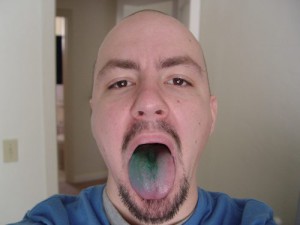
If the language darkens with time, this indicates that the person’s condition is deteriorating. A colorless tongue occurs in those who suffer from vitamin deficiency, anemia, or malnutrition. Very dark indicates the presence of acute chronic diseases that need urgent treatment.
The language, or rather its zones, exactly copy the human body. The tip of the tongue is the upper, and the root is the lower part of the trunk. Depending on which area of the body changes, one can judge the nature of a possible disease:
- the tip of the tongue tells about the work of the heart and lungs;
- its middle horizontally - on the state of the liver, stomach, spleen and pancreas;
- the root of the tongue is responsible for the intestines;
- sides will tell about the work of the kidneys;
- the middle of the vertical - corresponds to the spine.
Causes of blue bloom with photo
Why is the organ of taste suddenly turned blue (see photo)? The answer to this question will be given only by specialists after a complete examination of the body. Looking ahead, you can say that a person may have the following problems:
What if the language is cyanotic?
To get rid of the blue color of the language, you need to know why he became so. To do this, refer to the following doctors: a gastroenterologist, a dentist and a general practitioner. Only after consulting these specialists, who will conduct a visual inspection and collect a history, will you be given the appropriate treatment.
If it turns out that you have problems with the digestive system, the doctor will most likely prescribe antibiotics, antispasmodics, anti-inflammatory drugs. When vitamin deficiency will be assigned to a complex of vitamins and changes in the diet. If the problem arose due to dentures, the dentist will correct them. If any infection has become the cause of the blue body, the doctor will prescribe antibiotics or antifungal drugs.
In addition to the treatment of identified diseases, you must:
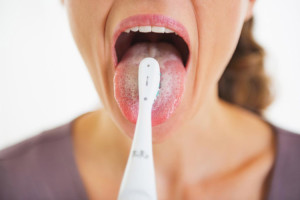
For rinsing, you can also use decoctions and infusions of herbs:
- chamomiles: 3 g of dried flowers steamed in 200 ml of boiling water and let stand for about 40 minutes, then strain and rinse 2 times or more per day;
- calendula: 5 g of dried flowers pour cold water and put on a small fire, after boiling - cool and strain, rinse your mouth after each meal;
- cloves and cinnamon: 2 g of cinnamon powder (1 stick) and 5 cloves of buds pour boiling water and leave to infuse for 20 minutes, rinse while warm.
Therapeutic diet
Regardless of what the cause of the bluish organ of taste, the first thing to do is to normalize the diet. From the diet should be excluded:

You need to eat often, but gradually. Ensure that the intestines are emptied in time. In the day you need to drink at least two liters of water without gas.
The diet menu should include the following products:

It is better to eat foods boiled, baked in the oven, grilled or in a double boiler. From the fried so far have to give up.
Ways to clean the tongue
To clean the tongue of plaque, fit a regular toothbrush. It can even be without a special rough lining, which is designed to care for the language. You can do without it. It is enough to take a brush of medium hardness and go with bristles from the root of the tongue to the lips, using antibacterial paste.
As a device for cleaning the tongue, you can use a specially designed for this purpose scraper. It can be plastic, wood or metal. Some specimens also have special brushes.
Conduct hygiene procedures language should be immediately after brushing your teeth. Move the scraper to the root of the tongue gradually moving to its end. Initially, the side with the brush is used, and then its hard side is applied, with which the tongue is massaged.
If you don’t have a brush or a scraper on hand, then you can use, for example, a teaspoon, a bandage wrapped around a finger, a clean towel or a textile napkin.
Indicator of our body
Did you know that language is not only an organ of taste and speech, but also a true imprint of the internal state of our entire organism? In both European and Eastern medicine, the importance of language has always been given to diagnostic language. Another well-known Russian doctor, M. Nechaev, wrote: “A tongue with simultaneous pathology of the spleen and liver, with convex, with abdominal dropsy, and pointed with venous swelling, is grooved with thick edges.
Earlier in medicine, inflammation of the gums and the oral mucosa were considered separately from the general state of the body, as a local process. However, at present, science has established that the appearance of the tongue, as well as the mucous membrane of the mouth as a whole, can help identify the most diverse diseases. It turns out that only 10% of diseases of the mucous membrane occurs due to local factors, mostly injuries. The remaining 90% often indicate diseases of the nervous system or internal organs. For example, in case of indigestion or irritation of the colon, ulcers occur in the oral cavity, and in cholecystitis (inflammation of the gallbladder), extensive erosions of the cheek mucosa.
No less important are the size, shape, color and general appearance of the language. According to M. Nechaev, bodily disorders can even cause curvature of the tongue: in the case of a disease of the organs of a certain half of the body, the corresponding side of the tongue changes in volume, and its tip is deflected. Nowadays, this symptom is taken into account, for example, by neuropathologists when making a diagnosis of “central paresis” (dysfunction of the hypoglossal nerve).
Better on an empty stomach
When starting a diagnosis, it must be remembered that spicy foods and spices, for example, marinades, cayenne pepper, curry, give the tongue a more red color for a short time. From smoking there is a yellow patina, and antibiotics, on the contrary, can cause a partial disappearance or sometimes a thickening of the plaque. Everyone knows how the use of intensely colored food - for example, beets or carrots, candy or lemonade - can change the color of the language. That is why it is advisable to eat nothing containing dyes on the day of diagnosis, and even better to conduct an inspection in the morning on an empty stomach. It is important that there be proper lighting, best of all - natural sunlight.
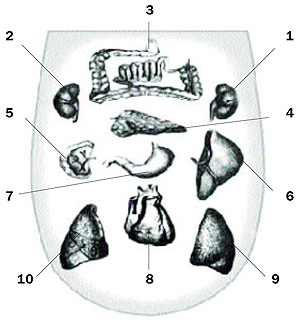
The projection of the internal organs in the language:
1 - left kidney, 2 - right kidney, 3 - intestines, 4 - pancreas, 5 - spleen, 6 - liver, 7 - stomach, 8 - heart, 9 - left lung, 10 - right degoca.
So let's do some research. All internal organs and the associated energy channels are projected on the corresponding parts of the language (see figure). Therefore, if in any particular part of the tongue you notice, for example, discoloration or hypersensitivity, this indicates a disturbance in those organs that are associated with this part.
About 3 cm from the tip of the tongue is a point of the heart, on the left side of the tongue is the left lung, on the right side is the right lung. The root of the tongue is the intestines. The place at the root of the tongue on the left side is connected with the left kidney, and on the right side with the right kidney. The projection of the liver is on the right side between the projection of the kidney and the right lung.
Stick out your tongue as much as possible (but without undue effort, as this can change the shape of the tongue and enhance the red tint) and look at it in the mirror. When language diagnostics play a role not only the color and surface of the language, but also its outlines, edges and size.
Color is an indicator of health
Normally, the color of the tongue is pink. Any deviations from this color may indicate certain diseases and pathologies. True, it also happens that the initial stage of the disease or a mild chronic disease occurs even with the normal color of the tongue.
- Red tongue - can assume ischemia, high body temperature; severe or infectious disease is possible.
- Dark red tongue indicates life-threatening forms of pneumonia, infectious diseases, severe renal impairment.
- Very pale - dramatic exhaustion, a sign or lack of blood in the body.
- Yellowish - there is an excess of bile in the gallbladder or abnormalities in the liver.
- Blue tongue - cardiovascular disorders,.
- Tongue with a dark purple shade -
